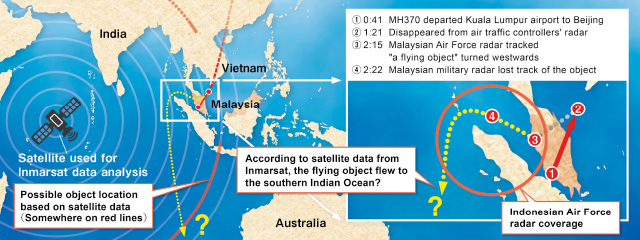Uncovering the Greatest Scandal in Aviation History (Part.1)
3 Years Since the Disappearance of Malaysia Airlines Flight MH370
Three years ago, Malaysia Airlines flight MH370 along with 239 passengers disappeared while flying above the South China Sea. It is widely believed that the aircraft crashed into the southern Indian Ocean, but there are is much evidence and analysis that does not lend itself to this established theory.
Early on 8 March 2014, Fight MH370 (Boeing 777-200ER), heading from Kuala Lumpur to Beijing, disappeared. The incident has almost faded into oblivion as the unsuccessful search for the aircraft culminated in January of this year.
What Happened to Our Loved Ones?
For people who lost family members in the incident, however, this case is far from closed.
There was a passenger on the MH370 named Chandrika Sharma from Chennai, India. She was an executive of the International Collective in Support of Fish workers (ICSF), and was heading to Mongolia for a conference.
Until moments before departure Chandrika was talking with her husband Narendran about their plans to build a dream house in the Nilgiri Hills. They had also planned a family trip to Europe with their daughter upon Chandrika’s return.
“It has been 3 years since the incident, but the sorrow of my wife’s disappearance is still fresh in my mind,” Narendran told The Liberty. “Every day I feel the difficulties of facing reality. Victim’s families cannot move on without clear information on what exactly happened to the plane.”



Narendran and his family, Chandrika is on the right.
Malaysian authorities explain that the flight made a sudden turn-around above the South China Sea and flew in the opposite direction from the planned route before crashing into the southern Indian Ocean. The search of the southern Indian Ocean was called off without any results.
Families responded at the March memorial gathering in Malaysia this year, demanding the recommencement of investigations. Later that month in South Carolina, U.S.A., families filed a lawsuit against the Malaysian government and Boeing.
More and more voices are demanding the truth behind the incident, while Malaysia Airlines and government authorities continue to refuse to disclose information regarding MH370.
What Happened to MH370 on That Day?
Let us review what we know about Flight MH370 and things related to it up and until January of this year.
Flight MH370, which departed Kuala Lumpur airport at 0:41am on 8 March 2014, was steady on its course until around 1:21am, 40 minutes after takeoff. This was when the aircraft disappeared from the radar of Malaysian air traffic control and Thailand’s military radar almost simultaneously.
What was strange was Malaysian Prime Minister Najib Razak’s reaction. He held the first press conference on the 15th, one week after the disappearance of the aircraft, and suggested the possibility that the plane was hijacked or there were problems with the pilot. After this, the press began spreading groundless theories such as the pilot had wanted to commit suicide, or that it must have been a terrorist incident. Various theories on what happened to MH370 have spread all over the world.
On 24 March, the Malaysian government concluded that the aircraft crashed into the southern Indian Ocean based on a new data analysis by British satellite telecommunications company ‘Inmarsat’. After that, some pieces of debris were actually found in the southern Indian Ocean, and the Malaysian government strangely announced that they belonged to MH370 without official confirmation by the investigation team.
These actions by the government made it look as if they were trying to shift attention away from the South China Sea to the southern Indian Ocean and close the case as quickly as possible. Investigations ended in January 2017, leaving the incident still unresolved.
Inspecting the Evidence
Did the MH370 really crash into the southern Indian Ocean?
How reliable is the Malaysian air force radar information that supports the southern Indian Ocean theory?
Inspection 1: Malaysian Military Radar Full of Contradictions

We know that Malaysian air traffic control lost the signal from MH370 at 1:21am when it was flying over the South China Sea. It means that the aircraft transponder stopped sending communication signals to air traffic control.
At the same time, MH370 disappeared from Thailand military radars. A military radar is not something that detects signals, but it detects whether an object really exists or not. From these two facts, the immediate assumption would be that the aircraft crashed exactly where it disappeared off the radar.
The strange thing was that two days after the disappearance, the Royal Malaysian Air Force announced that, “At 2:15am, we detected an unidentified object flying westward across the Malay Peninsula”. One week later, Malaysian authorities concluded that the unidentified object was MH370 without providing any evidence.
If it’s true that an unidentified object was detected by radar, military jets would have scrambled to intercept it, but the Malaysian Air Force says that they did not pursue the object.
Indonesian Air Force “Nothing Detected”
According to the Malaysian Air Force, the unidentified object was flying across the Strait of Malacca. But the Indonesian Air Force, who had been watching that area, argued that nothing was detected by their radar at that time. And in order to reinforce their claim, they have allegedly given the radar data to the Malaysian government.
If the Indonesian Air Force is correct, Malaysia’s claim that MH370 turned around and flew westward will be invalidated.
The Liberty magazine asked the Malaysian authorities how the government identified the unidentified object as MH370, and why their claim conflicted with that of the Indonesian Air Force. But the Malaysian government has not yet answered.
Inspection 2: Satellite Analysis Remains Uncertain
On 24 March, around 2 weeks after MH370 went missing, Malaysian Prime Minister Najib Razak concluded that the aircraft continued its flight to the southern Indian Ocean before crashing into the sea based on the satellite data from British satellite telecommunications company Inmarsat. Yet we must question the reliability of the data, which became the decisive factor in shifting the search area from the South China Sea to the southern Indian Ocean.
In his book “Why Did the Malaysia Airlines Flight Disappear?” former JAL pilot Hiroshi Sugie suggested “Everything about this satellite data is ambiguous. They say that the satellite was able to receive the weak PING signal from the aircraft and they calculated the Doppler shift, the aircraft’s assumed position, direction and speed to deduce the flight course. But we don’t know exactly what this weak signal was or which part of the aircraft it came from. While there were 5 or 6 satellites orbiting above the Indian Ocean, oddly enough only 1 was able to catch this weak signal.”
Premature Scientific Technology
“This satellite technology is underdeveloped, and we don’t know much about it yet,” says Captain Desmond Ross, an Australian aviation specialist with approximately three decades of experience as a pilot. “Even scientists at Inmarsat say that they can’t guarantee the calculations and conclusion are correct. I think the Malaysian authorities used this premature technology to blindly define the search area.”
On top of that, Prime Minister Najib Razak claims that Inmarsat told him MH370 crashed into the southern Indian Ocean, but Inmarsat argues that it was not them, but Malaysian Airlines, that came up with that conclusion.
It remains a mystery why the Malaysian government took the analysis data to jump to that conclusion.
Inspection 3: Southern Indian Ocean Debris May Not Be Part of MH370

Many pieces of Debris considered to be part of an aircraft have been witnessed floating in the South China Sea soon after MH370’s disappearance. However, instead of investigating them closely, Malaysian authorities identified the remains of a flaperon discovered in the Indian Ocean near Reunion Island as part of MH370. The flaperon was discovered in July 2015 and was transported to a research center in Toulouse, France. There it was confirmed that it belonged to a Boeing aircraft. In August, Prime Minister Razak concluded that it was part of MH370; but soon after, the research team commented that there was nothing that could conclusively prove its connection with MH370.
On What Grounds Did Malaysia Come to This Conclusion
French journalist, Florence de Changy, is one of the few people still investigating the truth behind the disappearance.
“You need an ID number to prove that the debris was part of the MH370, but the metal ID plate was unnaturally missing from the debris.
In addition, according to the maintenance record, the flaperon of MH370 was repaired in 2013. However, the investigation team said that they couldn’t find the repaired part on the debris.
Nevertheless, Prime Minister Najib Razak actually announced that the debris belonged to MH370 even before he received reports from the French investigation team. On what grounds did he come to this conclusion? It’s all very strange.”
Between the 1980s and the 1990s, at least two Boeing aircrafts have crashed in that area of the Indian Ocean. Even if the flaperon belonged to a Boeing aircraft, there is not enough evidence to link it to the MH370.
Interview
Crashes into South China Sea Moments After the Last Contact

Florence de Changy
Florence de Changy is a foreign correspondent, mainly affiliated with Le Monde and the French National radio, Radio France as well as RFI, Radio France International. She is the author of “Le Vol MH370 n’a pas disparu” (Les Arenes).

I think of the Malaysian government’s official narrative as an insult to human intelligence because the government says this plane has “disappeared”. In this day and age a B-777 does not “disappear”, especially in one of the most closely monitored regions of the world.
Clearly “someone is hiding something”, to quote former Prime Minister of Malaysia, Mahathir’s blog on May 18th, 2014. I don’t think Malaysia alone can manage such a sophisticated fabrication that required the complicity of several companies and governments. I think Malaysia is just “a scapegoat” and this cover-up is bigger than that. Boeing and Rolls Royce’s silence have puzzled everyone in the civil aviation circles.
Based on all the evidence that I have uncovered, it seems to me much more likely and logical that the crash happened shortly after contact was lost in the Gulf of Thailand. It’s because there is not a single independently established piece of proof or evidence to support the “airplane crashed into the Indian Ocean” theory.
I believe in the MH370 case there was a “cover-up”, and based on that I infer two scenarios. The first one is related to “a military operation”, which means the plane was shot involuntarily or destroyed by mistake. The other scenario is if the airplane had “a technical failure”: a fatal malfunction. People do not realize that accidents are easily caused by technical malfunctions.
I think it is important to prove that the captain was innocent. I spent a long time talking to several people who knew him well and had access to the police file about him to work out his personality. I became convinced that not only was he a very decent man but also an exceptional pilot. That helped me formulate scenarios in which the best of pilots failed to cope.
I cannot accept that governments and large companies fabricate such a nonsensical story, hoping that public opinion is stupid enough to accept it. Someone needs to say, “I do not believe this nonsense” and prove that it is nonsense.”
→To be continued to the Part.2, Inspecting the Evidence: What Are They Trying to Hide?



















